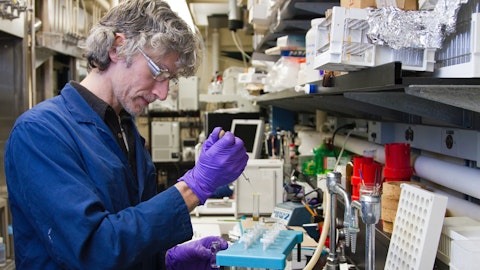And so this is really the – I believe probably some of the best solid tumor data that has ever been shown for CAR T, especially for an AlloCAR T. And so as we are moving forward, we want to be careful that we mitigate any emergent toxicity and so that when we get to the expansion cohorts, we have a good sense of what to expect.
Operator: Thank you. One moment as we move on to our next question. And our next question is going to come from the line of Hartaj Singh with Oppenheimer. Your line is open. Please go ahead.
Hartaj Singh: Great. Thank you. Just got a couple of questions and thanks for all the updates. My question a little bit more broad one is, just on 501A, your CD19 program, with the move of, for example, Gilead into second line LBCL. Over the last year, are you seeing sort of changes in those patients that are in third line LBCL? Are there more patients? I imagine the patient pool is probably increasing, but where is bone marrow transplant relative to that? Have things changed as autologous therapies have moved up early in lines of therapy. And then secondly, just on a manufacturing follow-up, for your lead program, are you technically in what would be a commercial material process, meaning that something that you’d be able to file your BLA with or are you sort of still in that clinical material process? Thank you.
David Chang: Yes, Hartaj. This is David Chang. So let me give Zach a little bit of break because he has been answering question after question. Your first question about 501A program and the approval of autologous CAR T early lines, and how that’s affecting our study. I think, sort of taking it from that point. Certainly, this is something that we had expected as the CAR T makes a way into the earlier line. And we are seeing this both in the CD19 program as well as announced in the today’s ASH abstract, a lot of abstracts cutting in the multiple myeloma with the BCMA targeting CARs. So in terms of 501A ALPHA2 study, the fact still is that there’s a large number of patients who are not getting access to the CAR T. So that segment is still open for us to tap into ALPHA/ALPHA2 study.
And one of the reasons that we are really trying to move to the earlier line as quickly as possible is to address the – this fundamental changes in the patient flow that we are witnessing in non-Hodgkin lymphoma. And we are certainly expecting that kind of changes in a multiple myeloma area. The second question about the manufacturing, this is something that we have worked on for a while just as our CFI manufacturing facility and it could potentially support the commercial launch. The process that we are using is really will be the basis for the commercial launch. So the answer to your question is yes.
Operator: Thank you. And one moment as we move on to our next question. And our next question is going to come from the line of Luca Issi with RBC. Your light is open. Please go ahead.
Unidentified Analyst: Oh, great. Thanks for taking our questions. This is Lisa on for Luca. Can you remind us of the timeline for when ALPHA2 and EXPAND could read out? And if you would have sufficient runway that would align with both of those data readouts? Thanks.
Zachary Roberts: Yes, so this is Zach. The – we are expecting our first look at the ALPHA2 data by the end of next year, and we expect to have some of the – some at least somehow EXPAND data around the same time. So as far as the runway goes, I’ll let others speak to it, but at the highest level, yes, we do have runway that would extend beyond those two data readouts.
Operator: Thank you. And I would now like to turn the conference back over to David Chang for any closing remarks.
David Chang: Yes. Thank you for joining us today and your ongoing faith in Allogene as we create the code for allogeneic CAR T. We will continue to do everything possible to validate your belief in our ability to make this a reality of patients. And look forward to sharing you – sharing with you important advances across our pipeline over the coming months. Operator, you may now disconnect.
Operator: This concludes today’s conference call. Thank you for participating. You may now disconnect.
Follow Allogene Therapeutics Inc. (NASDAQ:ALLO)
Follow Allogene Therapeutics Inc. (NASDAQ:ALLO)
Receive real-time insider trading and news alerts



